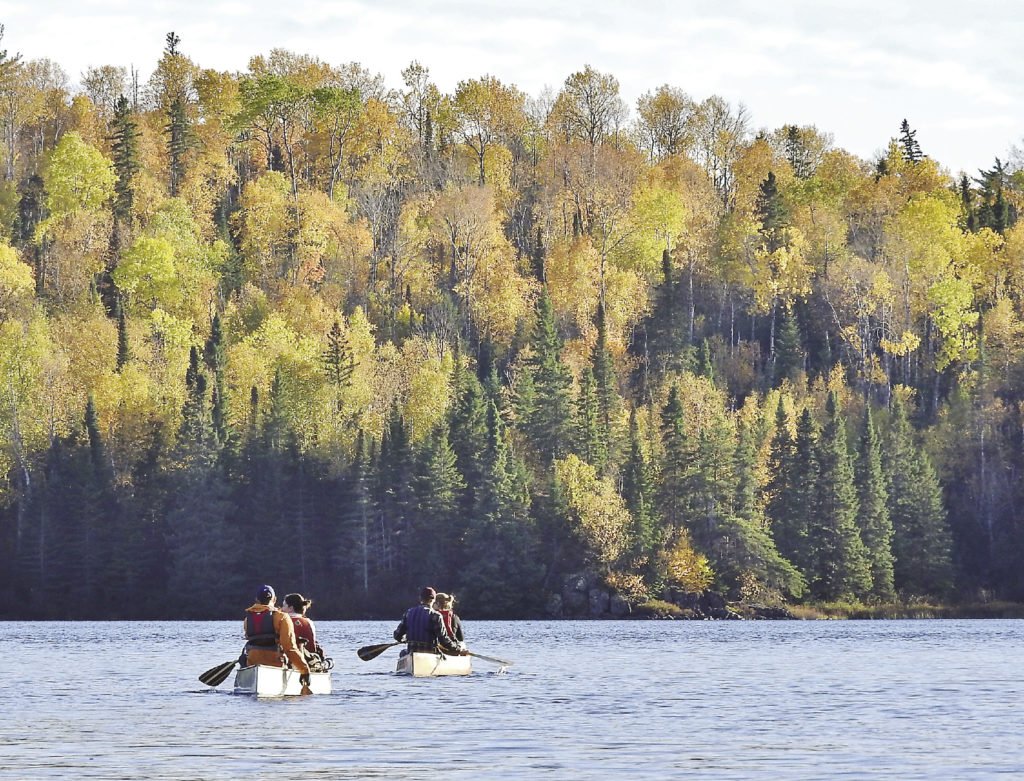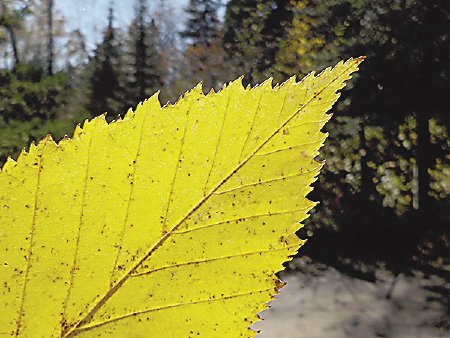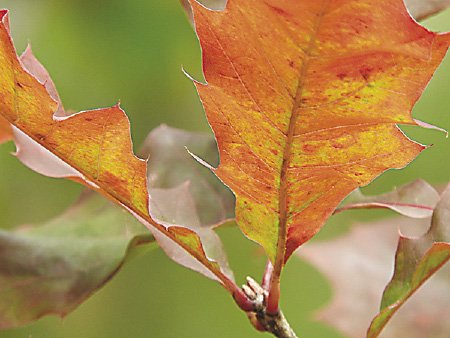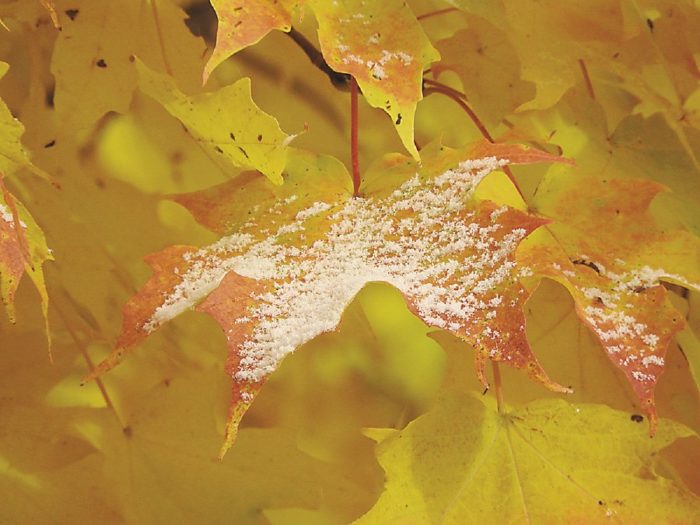Each year, beginning as early as August, red maple trees burst into flaming pyres of crimson leaves. It’s the ones in the swamps that go first, and they remind us that summer can’t last forever. They also comfort us with the knowledge that nature will put on a grand show before sliding in to the gray depths of winter.
There’s a long break between the first red maples and the next changing trees, but the sunny glow of spreading dogbane and the ochre shades of dying ferns along the roadsides keep the season marching along. By September, single leaves and individual branches of sugar maple trees have become their own little rainbows. Orange at the tips, yellow in the middle, and green closer in—there are few trees more spectacular than these.
As the season continues, a kaleidoscope of colors plays across the landscape. Bright reds finish early; then come the yellows of birch, aspen, and tamarack; and finally the deep red of oaks fade to brown. Stately spires of spruce, fir and pine hold their evergreen course and enrich the color palate.
We’re lucky to live in this swath of the continent known as the Northwoods, where fall colors are most spectacular. Go a little south, or head farther north, and the forest changes. According to John Pastor, Professor Emeritus from the University of Minnesota, Duluth, we have the extremes of our climate to thank for this autumn show. There’s something about the contrast of hot summers followed by frigid winters that encourages diversity in the shapes, colors and lifespans of our trees’ leaves.
At the risk of being a killjoy, I’d like to remind you that fall colors are all about death. We’ll start with a sort of obituary then—an explanation of the leaf lives we lose every fall.

Once the forest’s canopy attains its full set of green leaves to rustle in the summer breeze, the trees begin again to form new buds. The basic cells for leaves, as well as shoots and flowers, are neatly organized and packed tightly within protective scales or thick fur.
All winter, tiny and important, buds wait for the right cue. Some do not survive. Grouse, purple finches, deer, squirrels, moose, rabbits and hares all know what a fine winter food source those little packets are. When warmth and light return in the spring, those buds burst and the leaves expand.
Leaves are the sugar factories of plants. During photosynthesis, energy is transferred from photons of sunlight to green chlorophyll molecules and into a complex photosystem. Plants break apart molecules of carbon dioxide and water and re-combine them into sugars. From simple sugars, trees manufacture carbohydrates and cellulose, and those are used to build wood, grow flowers, provision seeds, fuel metabolism, and form buds.
Although almost every species of plant builds their own sugar factories (a few steal all of the sugar they need), those industrious leaves can look vastly different. In his book What Should a Clever Moose Eat?, John Pastor puts it into economic terms, characterizing leaves as “investments the tree makes that have benefits and costs.”
There’s a big investment at the outset of leaf growth, and then maintenance costs continue as long as the leaf is photosynthesizing. In order to come out ahead, plants must make sure that they’re producing enough to warrant the inputs. I envision a worksheet full of math problems, each representing a unique species. The equations contain different negative numbers representing the costs of tissue construction, maintenance, and reproduction. They also include various positive numbers of productivity. The answers, though, would all be the same: something just above 0.
Leaf shape is part of those equations. Pastor put a number on it: 80 percent of deciduous species in the Northwoods have leaves that are either toothed or lobed. What’s more, our northern leaves have both more teeth and bigger teeth than the few toothed species in the tropics. The correlation between leaf teeth and cool climates is so pronounced that paleoecologists use the percentage of toothed leaves in fossil plant communities to back-calculate prehistoric temperatures.

On the surface, it seems like a pretty random correlation. But scientists have determined that toothed leaf margins rev up their sugar factories faster in early spring than smooth leaf margins, thereby extending the growing season. The teeth also lose water at a higher rate, but water isn’t hard to come by during a Northwoods mud season, now is it?
Leaf lifespan is another variable in the equation. The more it costs to build a leaf, the longer it takes to pay off those costs. Evergreen trees invest significant energy into building needles that can withstand harsh weather, photosynthesize at lower temperatures, and ward off pests. Pine needles live two to three years, and spruce and hemlock needles last four to 10 years. In contrast, cheap, flimsy birch leaves last just a few months. Neither way is necessarily better. Each strategy finds success.
The photosynthesis factories chug along all summer, until at some point the waning sunlight can’t fuel enough sugar production to pay the maintenance bills of deciduous leaves. It’s time to close down the factories. Now the trees must try to salvage what they can. Nitrogen and phosphorus are sucked back out of the leaves and into the twigs, where they’ll remain on-deck to fuel next spring’s leaf growth. The tree benefits from storing N and P above ground, because the twigs thaw long before the frozen earth releases her nutrients.
Finally, we’re arrived at the onset of fall colors. Of course, they were there the whole time. All summer long, vibrant green chlorophyll was the star of the show, and outshone all the rest. As chlorophyll breaks down and is resorbed, though, its trusty sidekicks are revealed.
Orange carotene pigments capture wavelengths of light that the green chlorophyll cannot, and then transfer that energy over to help fuel photosynthesis.
Yellow xanthophyll pigments absorb dangerous excess energy in the leaf and dissipate it as heat. This prevents cell damage, and warms the surrounding environment. While walking through a golden carpet of fallen aspen leaves, I’ve often quipped that autumn is “the season when the sun shines up from the ground.” Maybe that’s more accurate than I’d supposed.

Red comes next. Once the phosphates have been resorbed into the twigs, sugars in the leaves break down and form anthocyanins. Anthocyanins absorb UV light, especially at low temperatures. Like sunscreen, the pigments protect the leaf cells while they finish sending their nutrients back to the twigs. They can be blue or purple, but their most conspicuous form is red. Red is the only fall color that is created and not just revealed.
To create anthocyanins you need lots of sugars, which means a summer with dependable soil moisture. Once summer’s over, though, cool, dry weather is the ticket. Rain literally washes the color out of the leaves—leaching pigments and sugars from dying cells.
While the forest becomes a rainbow, the deciduous trees are quietly growing several layers of cells across the base of the leaf’s stem where it is attached to the twig. Jack Frost doesn’t kill the leaves, because the trees themselves do. Finally, the abscission layer weakens the leaf’s hold on the tree just enough that a stiff breeze can whisk it away. That’s it. The Northwoods slides into the gray depths of winter, brightened only by the highly invested evergreens. Summer can’t last forever, but neither can fall, or winter, or spring. Next year, we’ll get to watch the kaleidoscope of colors play across the landscape all over again.
For more information, read What Should a Clever Moose Eat by John Pastor.




